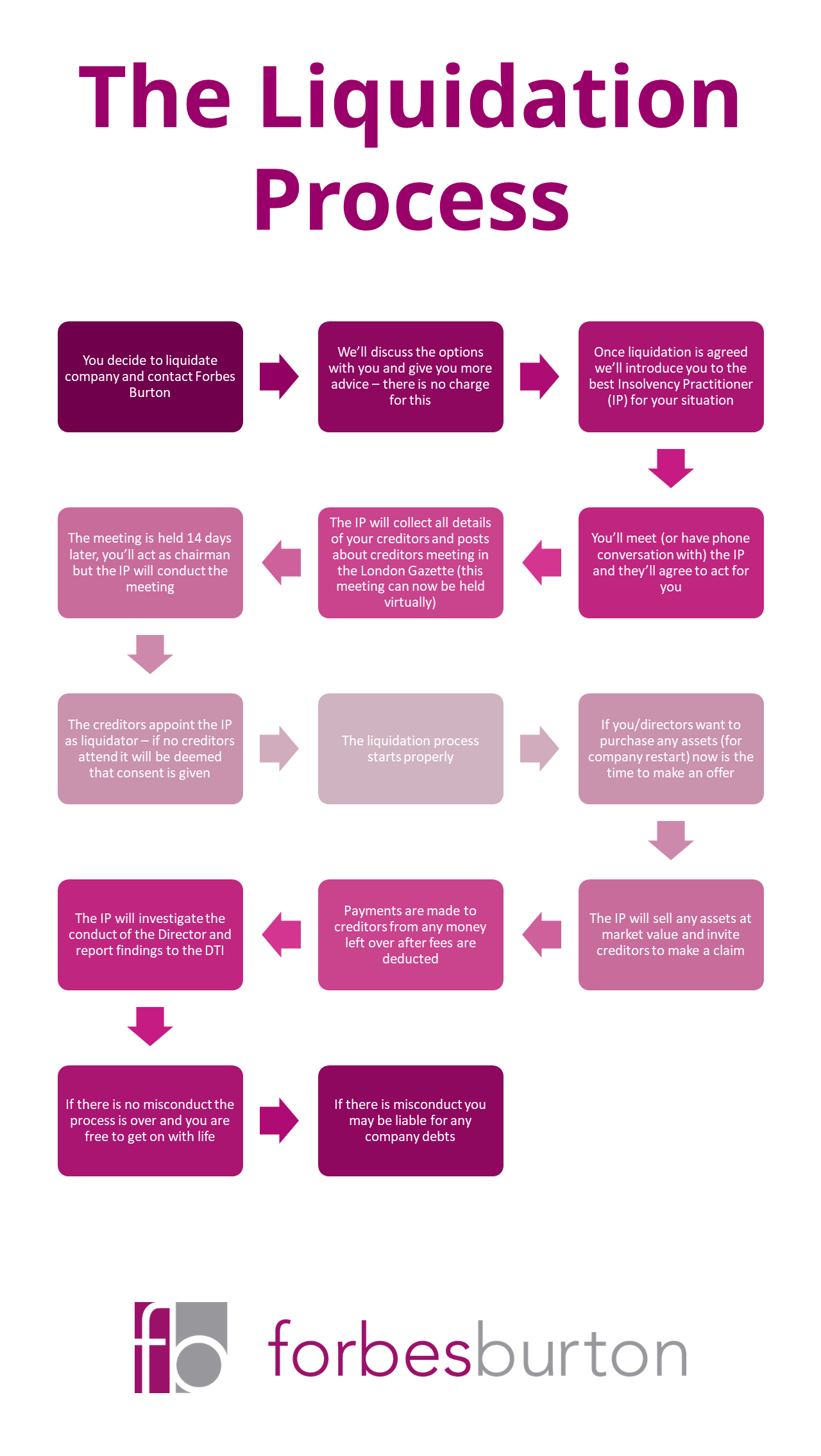
Liquidating a limited company
It can all become very confusing when you are sifting through information on-line to find out how the limited company liquidation process works, how much it will cost and how it will affect you.
We’ve compiled a simple, easy to read guide below which goes through how to liquidate a company, so that you know what you are signing up for when you put your company into a Creditors Voluntary Liquidation, also know as a CVL.
NOTE – If there are no assets or funds in the company then an alternative closure method called Dissolution could be used instead.
Thinking of liquidating your company?
Get a free, no-obligation quote today Limited Company Liquidation Quote →
Or you can call our advisers for some free, no-obligation advice on 0800 975 0380
What is the limited company liquidation process?
Although there are many parts to the liquidation process they can broadly be broken down into four separate areas.
1. Appointment of an insolvency practitioner
- Firstly, you’ll need to assess whether a liquidation is the right route for you and your company and choose who will carry it out
- An Insolvency Practitioner (IP) will then need to be informally appointed; this is the liquidator who will be in charge of the whole process
- They will gather the information that they need from the director, including company accounts, records, and also creditor, asset and cash flow information
- This information will be organised and official documents will be written up
- An assessment of the Statement of Affairs, the company’s financial position’ will usually be included here
- If the company is entering an Member’s Voluntary Liquidation (MVL), a Declaration of Solvency will also need to be signed at this point
2. Gazette publication
- The proposed liquidation action must be advertised in the Gazette (which is now solely an on-line publication)
- This is mandatory for all companies that are proposing closure, in the interest of creditors; it enables them to submit their claims to the correct party
3. Meeting of creditors
- Next, any creditors who put forward a claim are corresponded with. They must be given a certain period of time to respond
- They will either be notified at least 7 days before the creditors meeting, or given notice that unless they object to the process it will be going ahead
- Please note; Until very recently, physical creditors meetings were required, but this process can now be done virtually; it is down to the liquidator which path they will take, but increasingly, virtual meetings will now become the norm
- Deemed Consent; It is now possible for liquidators to assume that creditors consent to the liquidation unless they have objected to the process. This is referred to as ‘deemed consent’.
- If creditors meetings are held (virtually or otherwise), the intended IP will lead the meeting, although the company Director is technically the chairman
- These meetings are usually completely stress-free; creditors will vote to confirm that Liquidating the company is it’s best option, and that the liquidator can be officially appointed to oversee the liquidation
4. Liquidation (of assets, if any)
- The term liquidation actually refers to the sale and disbursement of the company assets i.e. turning something physical into ‘liquid’ cash
- The firm’s assets will be sold by the liquidator at their highest possible value and the cash will be used to pay off any company liabilities
- Usually, items will be auctioned, but it is possible for Directors to buy the assets themselves. However, the price must match that of an independent valuation, and this must be deemed to be in the best interests of the creditors
- After all the assets have been sold, the cost of the Liquidation (the Insolvency Practitioners fees) will be paid, and creditor claims will be settled
- The IP will then formally dissolve the company so that it is removed from the companies house register. Once this has been done the process is completed
Of course, in cases where there are little or no company-owned assets, the liquidators must still be paid. In this case, there are two options:
- An instalment agreement would be drawn up to pay the liquidator
- The IP takes on instruction on the understanding that a proportion of the director’s redundancy claim would be used to fund the liquidation when the payment has come through
Liquidation process flow diagram

How will putting my company into liquidation affect me?
In the vast majority of cases, the limited company liquidation process has no effect on company directors.
Of course, it will technically be public knowledge that you were once a director of a company that is now in liquidation, but this would only be seen if someone has done an in-depth search on you (and the outstanding debts are not public knowledge).
As far as your personal credit rating and reputation goes, there should be no lasting effect whatsoever.
There are, of course, exceptions; you will have heard the horror stories of personal liability and disqualification, but if any problems are going to arise, our job is to pin-point them beforehand, and we will advise the appropriate action.
Many people hear the word ‘liquidation’ and shudder, thinking that it is a very daunting process.
We hope that this simple guide has put your mind at rest, because in reality, our Insolvency Practitioners are not here to catch you out. They will explain each step of the process to you and do everything they can to put your mind at ease.
How long does a company liquidation take?
Generally it takes a month or two for the entire liquidation process to complete, a lot of it depends on how quickly creditors and other associated people can get information back to us.
The actual appointment of a liquidator can be done in around 7 days if there are no problems.
The larger the case the longer it normally takes. This is because of the time it takes to do investigations and get associated paperwork completed.
However, we have had some non-complex cases go through in as little as 14 days.
It is also worth bearing in mind that there is no legal time limit on a liquidation case.
Find out more about how long it takes to liquidate a company
How much does it cost to liquidate a company?
Again it depends on the case but a Creditors Voluntary Liquidation usually costs between £2500 – £6000.
Find out more about liquidation costs
Get some free liquidation advice today
If you think that liquidation is going to be right for your company, just call and speak to one of our friendly advisers for free (mobiles and landlines) on 0800 975 0380.
We’d be happy to talk through your options with you, and could even look into the amount of redundancy, which could be up to £9000, you would be entitled to prior to any decisions being made.
You can also find out if your company qualifies for Liquidation using our online test Take our free online liquidation test now →
Author

Ben Westoby
ben.westoby@forbesburton.com
Related Articles
We're here for you.
As a dedicated team of Advisers and Consultants our aim is to help you fix the issues and solve the problems within your business.
Find out more →

